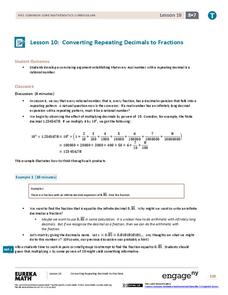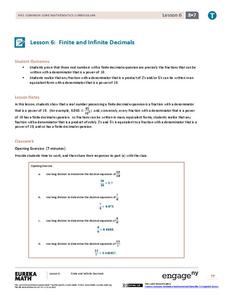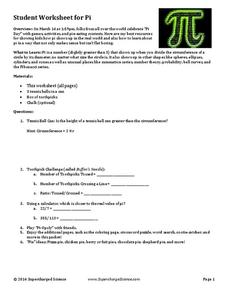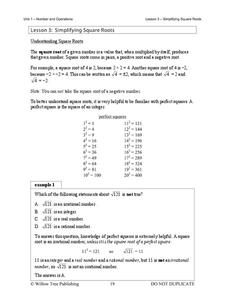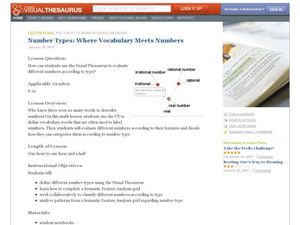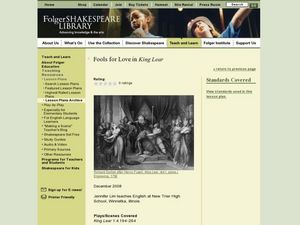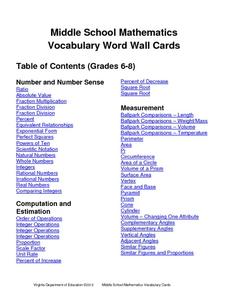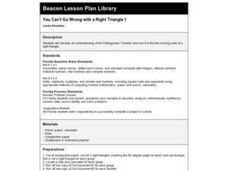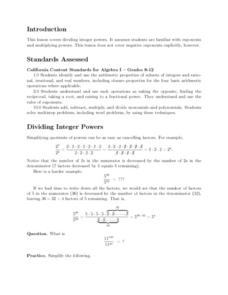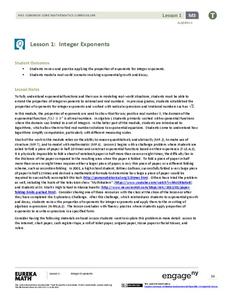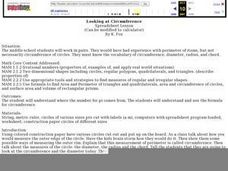Curated OER
Understanding Pi.
Learners study the relationship between circumference and diameter to come up with Pi. "In this pi instructional activity, students measure, record and find the ratio "circumference/diameter" and their average which is an approximation...
EngageNY
Converting Repeating Decimals to Fractions
Develop a process with your classes for converting repeating decimals to fractions. Through this process, pupils understand that any repeating decimal can be written as a fraction. The 10th lesson in this 25-part module helps...
EngageNY
Finite and Infinite Decimals
Explore the patterns of fractions that produce finite and infinite decimals. The sixth lesson of the series asks learners to determine a similar feature of fractions that produce finite decimals. Using the patterns, pupils create...
Curated OER
Worksheet for Pi
Who needs a pie-eating contest when you have a pi-ology game! Celebrate March 14th with a fun board game about pi and other geometric concepts. As learners answer questions about geometry, they move around the board to collect...
Texas Instruments
TI-Nspire™ CAS
When it comes to rating educational calculators, this calculator is always near the top of this list. Now it's available as an app. There is a lot of calculator power wrapped up in this app. Not only is this a fully functioning...
Mathematics Vision Project
Quadratic Equations
Through a variety of physical and theoretical situations, learners are led through the development of some of the deepest concepts in high school mathematics. Complex numbers, the fundamental theorem of algebra and rational exponents...
Willow Tree
Simplifying Square Roots
The square root of five and five do not have the same value! How many times have you addressed this with math classes? A lesson gives an explanation of a square root and gives examples for simplifying square root...
Curated OER
When Are We Ever Going to USE This MATH?
Fourth graders engage in discussion of various occupations and learn where math fits into the scheme of things. They are diagnostically assessed to determine proficiency in computer, writing, and problem-solving mathematical skills set...
Curated OER
What Does Percent Have to Do With It?
Fourth graders go shopping for a real life experience involving percent. They explore the concepts of sales tax and discount prices.
Curated OER
Number Types: Where Vocabulary Meets Numbers
Rational, irrational, real, natural. All these words can refer to numbers. Who knew? Learners use the Visual Thesaurus and a semantic feature analysis grid to examine the different attributes of numbers. Step-by-step instructions for...
Curated OER
Middle School Math
Students participate in a unit that introduces them to solving problems that is introductory to algebra. They look at positive and negative numbers on the number line and practice solving problems using the distributive property.
Curated OER
The Number System
Review complex numbers, real numbers, irrational and rational numbers, integers, and whole numbers with math students. Use this guide as a reference sheet or handout.
Curated OER
Fools for Love in King Lear
Students discuss the expression "fools for love." In this literature analysis lesson, students use King Lear as a basis for examining parent-child relationships. In small groups, they discuss the motives behind various...
Virginia Department of Education
Middle School Mathematics Vocabulary Word Wall Cards
Having a good working knowledge of math vocabulary is so important for learners as they progress through different levels of mathematical learning. Here is 125 pages worth of wonderfully constructed vocabulary and concept review cards....
Curated OER
You Can't Go Wrong with a Right Triangle 1
Fourth and fifth graders study the Pythagorean Theorem and apply it to find the missing side of a right triangle.
Curated OER
Whole Numbers
A game is a great way to learn. Study what makes an integers, their traits, and characteristics. This instructional activity includes 3 separate activities intended to promote an understanding of integers, whole numbers, and opposites....
Curated OER
Subtraction With Integers
This thorough introduction to the concept of subtracting negative integers walk learners through the necessary steps using teacher modeling and guided practice. Number lines and various word problems are used to support understanding of...
Curated OER
Dividing Integer Powers
Work on the concept of using division with integer powers. The skills of using exponents and multiplying powers should be in place before attempting this activity. The activity provides examples for the teacher to use for direct...
Curated OER
Academic Algebra II - 1st Semester Exam
In this solving quadratic equations worksheet, students solve 60 multiple choice and short answer problems. Students complete the square, factor, multiply, and solve quadratic equations.
Los Angeles County Office of Education
California State Standards: Algebra I
Starting a year of Algebra I? This mighty packet practices all of the major topics with different ranges of difficulty. Standards include everything from linear to quadratic to rational expressions. Use it in a...
EngageNY
Integer Exponents
Fold, fold, and fold some more. In the first installment of a 35-part module, young mathematicians fold a piece of paper in half until it can not be folded any more. They use the results of this activity to develop functions for the area...
Curated OER
Cutting Corners - Parts 1 and 2
Students use optimization concepts to design their own container. In this optimization lesson plan, students understand how the optimization concept is critical in calculus and why products are packaged the way they are.
Curated OER
Getting it Right! An Investigation of the Pythagorean Theorem
In order to learn about the Pythagorean Theorem, young mathematicians investigate relations and patterns between different sides of a right triangle to look for possible relations among the squared sides. Once they have established the...
Curated OER
Looking at Circumference
Young scholars understand where the number for pi comes from. They understand and use the formula for circumference. Students measure the circles given out and the diameters of those circles and record the results on their worksheet.

